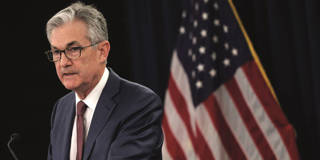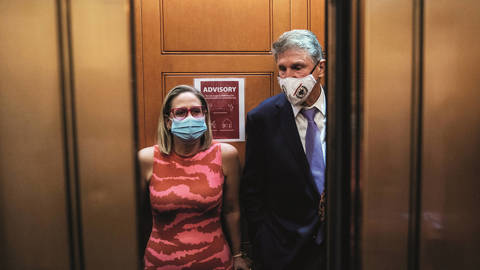Throughout 2021, top US economic policymakers held policy positions and deployed political rhetoric reminiscent of some of the darkest episodes of modern economic history. Leviathan is resurfacing, and it is bringing inflation with it.
CAMBRIDGE – One almost had to feel sorry for US Federal Reserve Chair Jerome Powell when, in congressional testimony this September, he expressed frustration at the inflationary pressures affecting the American economy. On the plus side, he finally acknowledged the existence of inflation that would last for more than a few months.
But then he went on to argue that the Fed’s expansionary monetary policy was not to blame. That policy includes near-zero short-term nominal interest rates, an enlargement of the Fed’s balance sheet to nearly $9 trillion, and asset purchases at a monthly rate of $120 billion. Only recently did the Fed commit to lowering its rate of purchases to $60 billion – meaning that the Fed’s balance sheet is still expanding! If there was ever an aggressive monetary policy, this is certainly it.
Powell continues to insist that today’s high inflation is all about temporary bottlenecks and supply-chain problems stemming from the pandemic-induced recession and the subsequent uneven recovery. According to this view, the Fed is merely a passive agent, trying its best to provide enough liquidity so that the supply-side inflation does not disrupt financial markets and the overall economy.
Powell’s interpretation of current events reminds me of the German central bank’s view in 1923, when it was presiding over that country’s post-World War I hyperinflation. According to the Reichsbank, the inflation derived from goods shortages attributable to foreigners, whose unreasonable reparations payments had caused a sharp depreciation of the German mark. In this scenario, the Reichsbank was a passive agent, trying as hard as possible to print currency to keep up with the rise in prices. As with Powell, the blame for inflation was put elsewhere – in this case on foreigners – rather than on the central bank’s own policies.
Of course, the Reichsbank’s account of the situation was not entirely wrong. Given that the German government and the central bank were relying on seigniorage revenue to pay for reparations, it is true that the reparations payments caused the monetary expansion and the ensuing inflation. But the Reichsbank’s willingness to print money was still a central part of the story.
Similarly, Powell is not entirely wrong when he attributes inflation partly to supply disruptions. But the Fed’s willingness to accommodate this process via monetary expansion – rather than fighting inflation by raising interest rates and selling off assets – remains a crucial factor.
In any event, if supply disruptions were the main story in 2020-21, they should also have seriously impeded the recovery of real (inflation-adjusted) GDP. Yet by the second and third quarters of 2021, the sharp V-shaped recovery since the third quarter of 2020 had already restored US real GDP roughly to its trend-adjusted 2019 level.
This V-shaped pattern was predictable, given that the recession in the first half of 2020 was essentially a voluntary choice to shut down much of the economy in response to the spread of COVID-19. Once this shutdown was substantially lifted, it was reasonable to expect that the economy would rapidly return to its previous level. Moreover, it is unclear that this speedy recovery owes much to the expansionary monetary policy or to the accompanying, aggressive fiscal policy.
With respect to fiscal policy, the addition of trillions of dollars of federal spending and public debt has been breathtaking. Parts of this policy may have helped the recovery, including the paycheck-protection program loans aimed at sustaining links between workers and businesses. However, the employment effects of PPP lending are controversial and not large. Moreover, the excessive payments to the unemployed likely held back the rebound in employment.
From the perspective of long-term economic growth, a well-designed package of infrastructure investment might make sense. However, pandemic-based excuses for spending more federal dollars are increasingly being used not to assist recovery or long-term growth but, rather, to support socialist dreams of a permanently expanded welfare state.
This vision reached its apotheosis with President Joe Biden’s Build Back Better agenda, which may still be living and includes four new entitlement programs. Frankly, I had not realized that the problem in US policy was a shortage of entitlement programs. I still recall President Bill Clinton declaring in 1996 that “the era of big government is over.” Where is Clinton when we need him?
I fear that the shift toward a permanently expanded public sector will impede US economic progress in the coming years. In some respects, we seem to be imitating the socialist agenda of Western Europe. But one important difference is that a substantial part of Europe’s tax revenue comes from value-added tax (VAT).
Lacking this comparatively efficient consumption tax, the United States will likely rely increasingly on inefficient taxes on capital (levies on corporate profits, capital gains, estates, overall wealth, and so forth). There will also be more emphasis on steeper graduation of tax schedules for personal income, which, as understood by President Ronald Reagan in the 1980s, implies inefficiently high marginal rates at high individual incomes.
To return to the outlook for prices, in November 2021, the 12-month-average consumer-price inflation rate reached 6.8% (based on the headline CPI). This gauge of inflation, similar to other standard measures, almost certainly will rise above 7% when the December number is factored in.
One worrisome sign is Biden’s move to blame greedy oil companies and other large corporations for rising prices. In a speech on September 16, he declared, “We’re … going after the bad actors and pandemic profiteers in our economy. There’s a lot of evidence that gas prices should be going down, but they haven’t. We’ll be taking a close look at that.” President Richard Nixon trafficked in the same sort of rhetoric in the 1970s, just before he imposed price controls that went on to inflict even more economic damage than that caused by open inflation.
The disgust with that earlier era of inflation eventually led President Jimmy Carter, in his finest hour, to appoint Paul Volcker as chair of the Fed in 1979. Volcker was not immediately viewed as a hero when he accepted that ending the high inflation of the early 1980s (then under Reagan) would entail a severe recession. But over time, his celebrity status grew as his contribution for taming inflation proved durable.
Powell is now in danger of earning the opposite reputation. So far, he has escaped much personal criticism. But if higher inflation becomes generally expected and therefore entrenched, which may have already happened, he will increasingly be blamed for it. The whole idea of monetary policy is to enact contractionary policies, including higher interest rates, before inflation rises a lot and before the unemployment rate falls to a target rate. From this perspective, the Fed is way behind the curve, and it is long overdue for Powell to shift to a Volcker-like contractionary monetary policy. What worries me, to paraphrase Senator Lloyd Bentsen from the 1988 vice presidential debate, is that one could legitimately look at Powell and say: “You’re no Paul Volcker.”






CAMBRIDGE – One almost had to feel sorry for US Federal Reserve Chair Jerome Powell when, in congressional testimony this September, he expressed frustration at the inflationary pressures affecting the American economy. On the plus side, he finally acknowledged the existence of inflation that would last for more than a few months.
But then he went on to argue that the Fed’s expansionary monetary policy was not to blame. That policy includes near-zero short-term nominal interest rates, an enlargement of the Fed’s balance sheet to nearly $9 trillion, and asset purchases at a monthly rate of $120 billion. Only recently did the Fed commit to lowering its rate of purchases to $60 billion – meaning that the Fed’s balance sheet is still expanding! If there was ever an aggressive monetary policy, this is certainly it.
Powell continues to insist that today’s high inflation is all about temporary bottlenecks and supply-chain problems stemming from the pandemic-induced recession and the subsequent uneven recovery. According to this view, the Fed is merely a passive agent, trying its best to provide enough liquidity so that the supply-side inflation does not disrupt financial markets and the overall economy.
Powell’s interpretation of current events reminds me of the German central bank’s view in 1923, when it was presiding over that country’s post-World War I hyperinflation. According to the Reichsbank, the inflation derived from goods shortages attributable to foreigners, whose unreasonable reparations payments had caused a sharp depreciation of the German mark. In this scenario, the Reichsbank was a passive agent, trying as hard as possible to print currency to keep up with the rise in prices. As with Powell, the blame for inflation was put elsewhere – in this case on foreigners – rather than on the central bank’s own policies.
Of course, the Reichsbank’s account of the situation was not entirely wrong. Given that the German government and the central bank were relying on seigniorage revenue to pay for reparations, it is true that the reparations payments caused the monetary expansion and the ensuing inflation. But the Reichsbank’s willingness to print money was still a central part of the story.
Similarly, Powell is not entirely wrong when he attributes inflation partly to supply disruptions. But the Fed’s willingness to accommodate this process via monetary expansion – rather than fighting inflation by raising interest rates and selling off assets – remains a crucial factor.
SPRING SALE: Save 40% on all new Digital or Digital Plus subscriptions
Subscribe now to gain greater access to Project Syndicate – including every commentary and our entire On Point suite of subscriber-exclusive content – starting at just $49.99.
Subscribe Now
In any event, if supply disruptions were the main story in 2020-21, they should also have seriously impeded the recovery of real (inflation-adjusted) GDP. Yet by the second and third quarters of 2021, the sharp V-shaped recovery since the third quarter of 2020 had already restored US real GDP roughly to its trend-adjusted 2019 level.
This V-shaped pattern was predictable, given that the recession in the first half of 2020 was essentially a voluntary choice to shut down much of the economy in response to the spread of COVID-19. Once this shutdown was substantially lifted, it was reasonable to expect that the economy would rapidly return to its previous level. Moreover, it is unclear that this speedy recovery owes much to the expansionary monetary policy or to the accompanying, aggressive fiscal policy.
With respect to fiscal policy, the addition of trillions of dollars of federal spending and public debt has been breathtaking. Parts of this policy may have helped the recovery, including the paycheck-protection program loans aimed at sustaining links between workers and businesses. However, the employment effects of PPP lending are controversial and not large. Moreover, the excessive payments to the unemployed likely held back the rebound in employment.
From the perspective of long-term economic growth, a well-designed package of infrastructure investment might make sense. However, pandemic-based excuses for spending more federal dollars are increasingly being used not to assist recovery or long-term growth but, rather, to support socialist dreams of a permanently expanded welfare state.
This vision reached its apotheosis with President Joe Biden’s Build Back Better agenda, which may still be living and includes four new entitlement programs. Frankly, I had not realized that the problem in US policy was a shortage of entitlement programs. I still recall President Bill Clinton declaring in 1996 that “the era of big government is over.” Where is Clinton when we need him?
I fear that the shift toward a permanently expanded public sector will impede US economic progress in the coming years. In some respects, we seem to be imitating the socialist agenda of Western Europe. But one important difference is that a substantial part of Europe’s tax revenue comes from value-added tax (VAT).
Lacking this comparatively efficient consumption tax, the United States will likely rely increasingly on inefficient taxes on capital (levies on corporate profits, capital gains, estates, overall wealth, and so forth). There will also be more emphasis on steeper graduation of tax schedules for personal income, which, as understood by President Ronald Reagan in the 1980s, implies inefficiently high marginal rates at high individual incomes.
To return to the outlook for prices, in November 2021, the 12-month-average consumer-price inflation rate reached 6.8% (based on the headline CPI). This gauge of inflation, similar to other standard measures, almost certainly will rise above 7% when the December number is factored in.
One worrisome sign is Biden’s move to blame greedy oil companies and other large corporations for rising prices. In a speech on September 16, he declared, “We’re … going after the bad actors and pandemic profiteers in our economy. There’s a lot of evidence that gas prices should be going down, but they haven’t. We’ll be taking a close look at that.” President Richard Nixon trafficked in the same sort of rhetoric in the 1970s, just before he imposed price controls that went on to inflict even more economic damage than that caused by open inflation.
The disgust with that earlier era of inflation eventually led President Jimmy Carter, in his finest hour, to appoint Paul Volcker as chair of the Fed in 1979. Volcker was not immediately viewed as a hero when he accepted that ending the high inflation of the early 1980s (then under Reagan) would entail a severe recession. But over time, his celebrity status grew as his contribution for taming inflation proved durable.
Powell is now in danger of earning the opposite reputation. So far, he has escaped much personal criticism. But if higher inflation becomes generally expected and therefore entrenched, which may have already happened, he will increasingly be blamed for it. The whole idea of monetary policy is to enact contractionary policies, including higher interest rates, before inflation rises a lot and before the unemployment rate falls to a target rate. From this perspective, the Fed is way behind the curve, and it is long overdue for Powell to shift to a Volcker-like contractionary monetary policy. What worries me, to paraphrase Senator Lloyd Bentsen from the 1988 vice presidential debate, is that one could legitimately look at Powell and say: “You’re no Paul Volcker.”